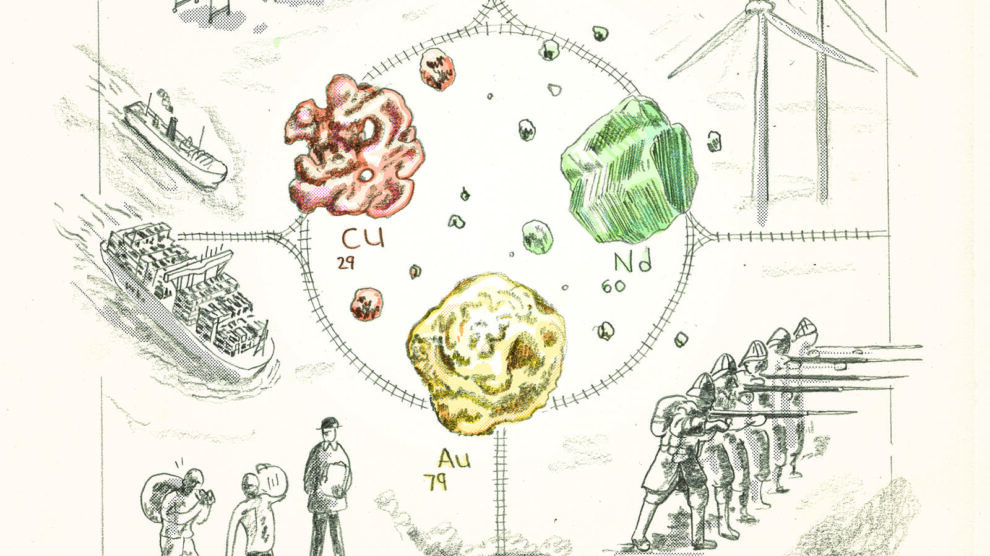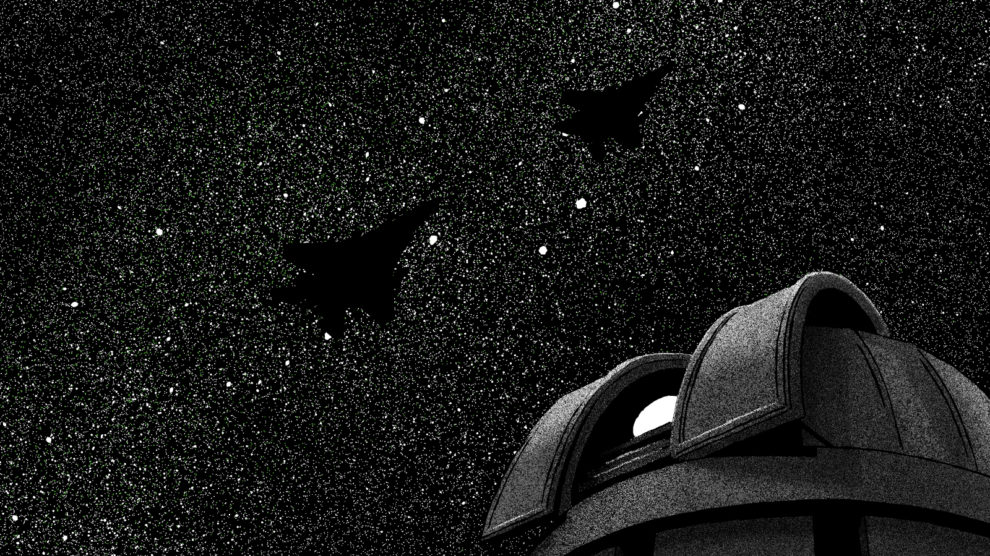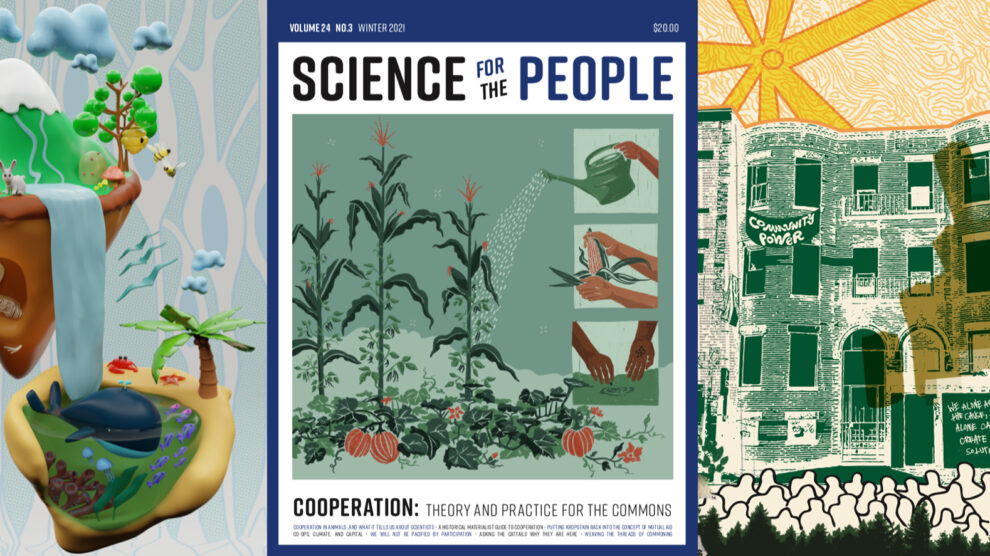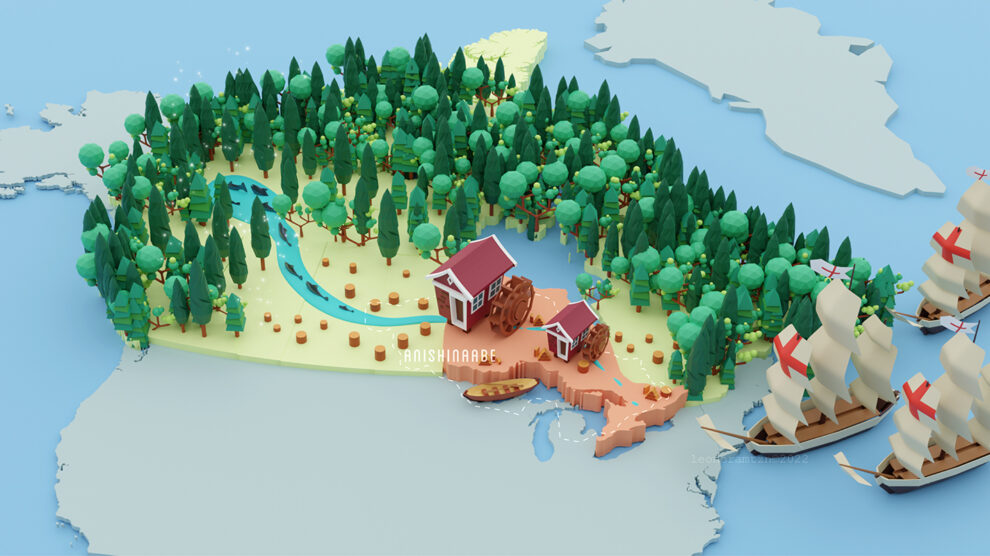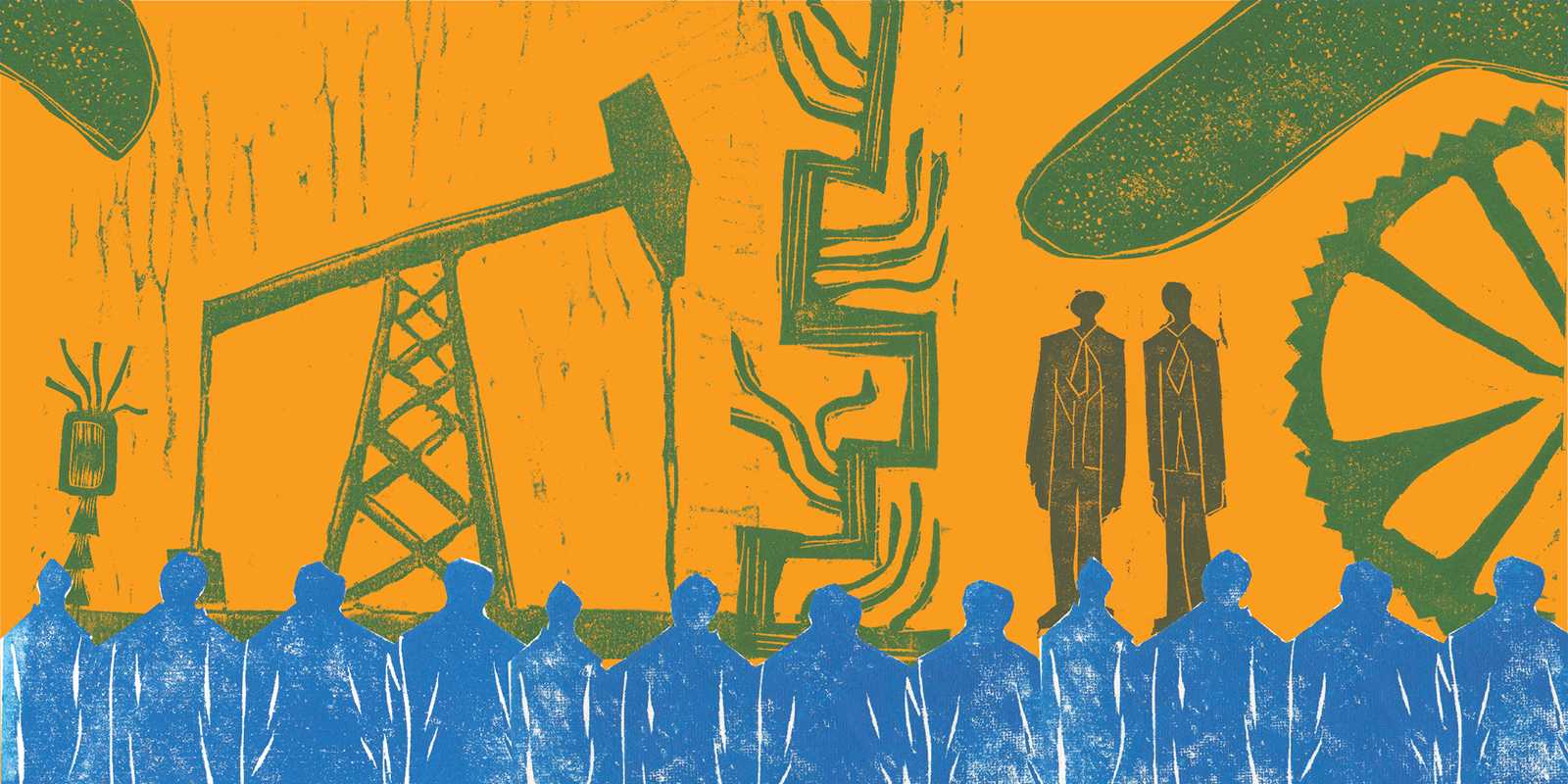
Fossil Drugs: Antibiotics as the Fossil Fuels of Medicine
By Liam Shaw
Volume 25, no. 2, Bleeding Earth
The discovery of antibiotics was one of humanity’s greatest achievements. But we didn’t invent them. Long before humans, microorganisms in soil evolved these molecules. It was not until the mid-twentieth century, however, that these molecules were isolated by humans and mass-produced for medicine.
At first antibiotics seemed like a miracle. However, they are different from most drugs. When an antibiotic is administered, it often exerts a selective pressure for resistant bacteria. This applies not only to the bacteria causing the infection but also to other species. It is also not an individual risk but one that can spread. Every dose risks the next dose becoming less effective. The finite nature of antibiotic effectiveness is unavoidable—their use alters their environment.
I believe we can understand antibiotics by analogy with fossil fuels. Both are natural resources extracted from the earth. Both developed slowly but have been rapidly exploited by humans. And both disrupt ecosystems, creating problems for the future. Like climate change, antibiotic resistance can be understood as an inevitable ecological correction to “fossil capitalism”—an economic model built on borrowed time. Just as fossil fuels have powered modern economies, so too have antibiotics powered modern medicine. This essay explores the idea of antibiotics as fossil drugs.
Deep Time
By the 1900s, microbiologists had identified bacteria as the cause of many diseases. But despite this understanding, there were few cures. Chemical industries produced vast numbers of new compounds, but not many were effective medicines. The difficulty was not in killing bacteria but in finding medicines that did so without harming the human body.
Most medicines work by interfering with human biological pathways. Paracetamol relieves a headache by inhibiting pain pathways; caffeine wakes us up by blocking receptors in the brain. In contrast, an ideal bacteria-killing molecule leaves human cells unaltered. Early efforts to find such “magic bullets” focused on synthetic compounds, as chemists randomly tinkered with toxic compounds to harness their killing power while reducing side effects.1 Progress was slow. Then came an entirely different approach.
In 1930, René Dubos was a young microbiologist looking for a drug that would destroy the tough outside capsule of a bacteria that caused pneumonia. But he was looking in a strange place. Dubos was motivated by the idea that soil was a self-purifying environment. Almost everything that goes into soil turns to soil: mighty trees fall, then disappear.
This organic degradation relies on bacteria and other microorganisms. Just a teaspoon of soil contains more than one billion bacterial cells. We can imagine each as a microscopic factory teeming with chemical reactions. As his colleague Rollin D. Hotchkiss recalled, Dubos formulated a general hypothesis: that soil “could supply an agent to destroy disease-causing bacteria.”2 To find that agent, Dubos added a “nutrient soup” of disease-causing bacteria to tumblers of soil, isolated the soil bacteria that survived, and extracted the key compounds. His research led to the identification of two different antibiotics.3 Using soil bacteria to kill pathogens was a true paradigm shift.
When Pfizer identified its first promising antibiotic candidate in late 1949, the head of the company, John McKeen, chose the name Terramycin: “I wanted a name connected with the earth . . . because it came from the earth.”
In abandoning laborious chemical synthesis, the search for antibiotics had arrived at a deep truth, often known as Orgel’s Second Rule: “Evolution is cleverer than you are.”4 Others adopted this approach, notably the Ukrainian-American scientist Selman Waksman. Many of the antibiotics discovered in Waksman’s lab were made by Streptomyces, a genus of bacteria within the actinomycetes, which form long filaments as they branch out through the soil.5 Certain phases of their life cycle coincide with a rise in the production of antibiotic molecules, likely at times when their slender cells are most vulnerable.
One antibiotic, produced by Streptomyces griseus, would prove enormously significant. Experiments by Albert Schatz and Elizabeth Bugie in 1944 isolated a compound with activity against a huge range of medically important bacteria. It was water-soluble and had limited toxicity to animals: the ideal antibiotic.6 Yet they didn’t even know its structure.
Streptomycin was a molecular tangle of carbon, hydrogen, nitrogen, and oxygen. The likelihood of designing it from scratch was tiny. Yet its structure was not random chance but existed thanks to the ingenuity of evolution as a tinkerer. It had undergone countless experiments with molecular variants, just not experiments conducted by humans. The accumulation of evolution over deep time had enabled an incredible shortcut. Streptomycin was the first effective antibiotic to treat tuberculosis.
After the success of streptomycin, pharmaceutical companies started to use the same screening approach to search for treatments for different infections. Despite the prominence of penicillin—produced by fungi and (supposedly) discovered by chance—this screening approach led to almost all post–Second World War antibiotics. The earthy origins of these new drugs gave them a “natural” appeal.7 When Pfizer identified its first promising antibiotic candidate in late 1949, the head of the company, John McKeen, was the one who chose the name. As he explained, “I wanted a name connected with the earth … because it came from the earth.” He settled on “Terramycin.”8
Where else do we see molecules extracted from the earth to drive progress? Fossil fuels. While oil and gas are not made by bacteria today, they were once generated through a slow process started by bacteria. As with fossil fuels, antibiotics were a natural resource. And they were one that capitalism would exploit through extraction at scale.
The Logic of Extraction
The discovery of a new use can transform a commodity’s value. Consider crude oil. It was known for centuries, but until the mid-nineteenth century, it had limited use. The technology of oil refinement changed that, and vast swathes of land across the United States were ripped up for drilling. The technologies of the early antibiotic age similarly transformed the soil.
As the cover of Time put it in November 1949, “The remedies are in our own backyards.”9 This required screening hundreds of thousands of samples and finding antibiotic needles in a vast geochemical haystack. Large pharmaceutical corporations were best placed to compete—particularly those who had received wartime government funding to expand penicillin production10—supported by the many workers needed for identification and subsequent mass production. Inevitably, surplus value was extracted. Exploitation applied in science too. Waksman took the credit for streptomycin, minimizing the contributions of Schatz and Bugie.11
The realization that dirt hid powerful antibiotics prompted something akin to the American oil rush. Streptomycin had come from soil on a chicken farm, so early efforts focused on agricultural soil. But although antibiotic screening required only tiny amounts of soil, corporations came to realize they should collect diverse samples to maximize the chance of finding something others wouldn’t. The more exotic, the better.
The global search was big business. Venezuelan compost obtained from a Basque emigrant farmer led to chloramphenicol. Vancomycin was developed from a soil sample sent by a missionary in Borneo.
No stone was left unturned. Pfizer received 135,000 soil samples from cemeteries, mine shafts, the bottom of the ocean, and even airborne soil collected with balloons.12 Parke-Davis sent their entire sales division off with plastic bags to bring back soil from their travels.13 A Bristol-Myers Squibb annual report included an envelope requesting a “teaspoon of soil” from shareholders.14 This desire for soil dovetailed with colonialism, as evident in 1956 when Nature summarized a report from the British Colonial Research Council, noting that the search for “new antibiotic-producing organisms” from “Malayan soil” continued.15
The global search was big business. Venezuelan compost obtained from a Basque emigrant farmer led to chloramphenicol. Vancomycin was developed from a soil sample sent by a missionary in Borneo. Both of these drugs were patented in the United States. (Such a “bioprospecting” approach to natural products, some of which are already used in traditional medicines, continues today.16)
Antibiotics produced in the post–Second World War period were lucrative pharmaceutical products, aggressively advertised as treatments for myriad conditions, even when there was no evidence antibiotics were effective. Most had few side-effects on patients.17 However, many were “broad-spectrum” and affected a range of bacterial species—all of which could evolve resistance and spread between humans, even if not the intended targets of the treatment.
Despite rising concerns about resistant bacteria, corporations deliberately sold the drugs as much as possible, generating large profit margins. It was an effective cartel where competing companies sold their products at the same price.18 However, the true price of antibiotics—increasing resistance rates—was not one borne by business. Resistance was what economists call a “negative externality”: a cost passed on to somebody else.
Antibiotics present multiple economic challenges. Today, awareness of antibiotic resistance means that new antibiotics will be safeguarded and used far less. Antibiotics have become less desirable for big pharmaceutical corporations to develop. Consequently, antibiotic development has slowed. This “market failure” is often framed as one to be overcome with the right “incentives,” usually focusing on patent rights.
Some economists are proposing strange “pull mechanisms” that use public money to guarantee private profit.19 For example, one proposal growing in popularity (including with corporations) is so-called Transfer Exclusivity Extension (TEE) vouchers, which would reward the discovery of a new antibiotic with the ability to extend patent rights on a different, non-antibiotic drug.20
The Inefficiency of Success
Though now one of the most famous and ubiquitous antibiotics, penicillin was once so scarce that doctors had to recycle it from their patients’ urine for reinjection.21 But once mass production was possible, such restraint ended. Today, antibiotic use is astonishingly inefficient.
First, the use of antibiotics leads to environmental pollution. This inefficiency is linked to their potency. Like fossil fuels, antibiotics are so powerful that they allow profligacy. Between 40 and 90 percent of an administered antibiotic may be excreted from the body unused.22 The manufacturing process of antibiotics also produces huge quantities of waste antibiotics. This release into the environment contributes to antibiotic resistance that may reenter human populations.23
Second, antibiotic effectiveness has undoubtedly slowed research into other forms of treatment. Phage therapy, for example, involves viruses that attack bacteria in a much more specific way than antibiotics can. But the mass production and ease of antibiotics led many countries to abandon phage therapy.
Third, many antibiotics started to be used before conservation was a concern. This is particularly true for patients prescribed a course of oral antibiotics to be taken at home. In these settings, the necessary length of the course is debated. We often lack good evidence for standard durations; when shorter courses for common infections have been tested, most have shown no worsening patient outcomes.24 Because antibiotic use like this typically selects for resistance in bacteria beyond the target infection, more antibiotic use contributes to more resistance, regardless of whether the course is completed. Balancing individual needs for treatment against the collective is a challenge.
Life Out of Balance
We might assume that antibiotics play the same role in nature as in medicine: to kill other bacteria. Yet most natural antibiotics in soil occur at such low and local concentrations that this seems unlikely to be their only function. These low levels may also promote cooperative bacterial behaviors such as biofilm formation.25 Whatever their natural roles, the ancient origins of antibiotics mean that resistance is ancient too. For any possible antibiotic, there is a resistance gene somewhere out there—in the soil.26
I have focused on the similarities between antibiotics and fossil fuels, but there are clear differences. One of the most important is that there is no finite physical supply of antibiotics. We can continue to manufacture as much as we wish, but we will continually face the limits of their effectiveness. We can think of these as “effectiveness” reserves by analogy with fossil fuel reserves. Unrestrained use of antibiotics depletes these reserves; the greater the rate of usage, the faster the depletion. Worse, shared resistance mechanisms mean that the effectiveness reserves of different antibiotics often overlap. But there is cause for hope: these reserves can be slowly renewed over time by evolution if sensitive bacteria outcompete resistant bacteria in the absence of antibiotics.27 Better usage should help.
Not all antibiotics come from the soil. While the post-war antibiotics did, many antibiotics developed since then are synthetic, such as the successive “generations” of cephalosporins.28 But even these have, in turn, led to the successive spread of versatile resistance genes that degrade them. The fact is that every molecule used as an antibiotic will be a fossil drug—in the sense that it must, in evolutionary terms, lead to resistance. There is no escaping Orgel’s Second Rule. Like burning fossil fuels, the overuse of antibiotics strongly perturbs natural systems. Natural systems are not static but dynamic. The climate will change; bacteria will evolve. We have to adjust to that reality.
Conclusion
At the start of this essay, I described capitalism as an economic model built on borrowed time. That time is borrowed from ecosystems and will eventually be paid back. We should recognize the vast (albeit uneven) economic growth and concomitant increases in health that capitalism has overseen as the dominant global economic system. But it has been powered by the contingent availability of slowly-formed natural resources. Growth is not an iron law but a short-term consequence of the depletion of natural resources accumulated over millions of years. The logic of extraction creates lasting ecological problems: pollution, resistance, and climate change. In this sense, fossil capitalism steals time from the past and the future.
Antibiotic resistance has been described as the next pandemic. Yet it is increasingly arriving if unequally distributed. Regions in the Global South experience the highest burden from resistant infections.29 Antibiotic resistance is an issue of global equity. As with climate change, it is unacceptable for richer countries to improve practices without offering support to poorer countries to do the same.
Evolution is inevitable, so resistance is not something we can ever completely prevent. We need balance, making every effort to use antibiotics more sparingly while researching alternatives. Ian Angus argues in Facing the Anthropocene (2016) that fossil fuels “are not an overlay that can be peeled away from capitalism, leaving the system intact.”30 In the same way, antibiotics cannot simply be replaced in medicine. All the more reason to consider different approaches to nature—ones that don’t presume the profits of corporations align with humanity’s best interests. The political economy of antibiotics should convince us that the logic of extraction creates short-term success at the cost of long-term disaster.
My focus has been history. There is more to say about the future than I have space for here. But it seems clear that we need to imagine a society that does not rely on pharmaceutical companies to turn public research on natural resources into medicines. We should be radical and aim for a genuinely public research and development pipeline. A first step could be the formation of a global institute for antibiotics while ensuring equitable access to the drugs produced. As fossil drugs, antibiotics are a shared resource. Separating them from extractive logic is essential.
Please subscribe to help us publish more articles like this.
Notes
- The term “magic bullet” is attributed to Paul Ehrlich, from the German Zauberkugel. The English term Ehrlich first used was “charmed bullets” in a 1907 lecture. See Paul Ehrlich, Experimental Researches on Specific Therapeutics (London: H. K. Lewis, 1908), 6.
- Rollin D. Hotchkiss, “From Microbes to Medicine: Gramicidin, René Dubos, and the Rockefeller” in Launching the Antibiotic Era, ed. Carol L. Moberg and Zanvil A. Cohn (New York: Rockefeller University Press, 1990). As quoted in Carol L. Moberg, René Dubos, Friend of the Good Earth: Microbiologist, Medical Scientist, Environmentalist (Washington, D.C.: ASM Press, 2005), 48.
- They were tyrothricin and gramicidin. See Moberg, René Dubos, Friend of the Good Earth, 48. In 1930 Dubos had fed just the capsule component of Streptococcus pneumoniae. In 1937 he used “the same philosophy and techniques” on a cocktail of “staphylococci, pneumococci, and hemolytic streptococci.”
- See Jack D. Dunitz and Gerald F. Joyce, “Leslie Eleazer Orgel: 12 January 1927 — 27 October 2007,” Biographical Memoirs of Fellows of the Royal Society 59 (2013): 277–89, https://www.jstor.org/stable/42705811.
- Bacterial taxonomy is complex and often revised. Streptomyces species are within a phylum (a higher taxonomic order) called Actinomycetota, which also includes marine bacteria. The name actinomycetes literally means “ray-like fungi”; they were classified by shape, and it was first assumed they were fungi because of their visual similarity to mycelial networks.
- Albert Schatz, Elizabeth Bugie, and Selman A. Waksman, “Streptomycin, a Substance Exhibiting Antibiotic Activity Against Gram-Positive and Gram-Negative Bacteria,” Experimental Biology and Medicine 55, no. 1 (January 1944): 66–9.
- The rhetoric connecting men who “discovered” antibiotics to the earth was widespread. Dubos was dubbed “friend of the good earth” (e.g., Moberg, René Dubos, Friend of the Good Earth). Waksman was called “Man of the Soil” in Time, April 4, 1949, 42–4. The admiring journalist notes seriously that Waksman is “a soil expert, but he cannot find time for gardening.”
- Jeffrey L. Rodengen, The Legend of Pfizer (Fort Lauderdale: Write Stuff Syndicate, Inc., 1999), 79. At this point Pfizer did not actually sell any drugs. The chairman of the board commented in 1950: “If anything comes out of this antibiotic soil-screening program, don’t make the mistake we made with penicillin and hand it over to other companies. Let’s sell it ourselves. Go into the pharmaceutical business if we have to.”
- Front cover of Time, November 7, 1949.
- See the discussion in William Rosen, Miracle Cure: The Creation of Antibiotics and the Birth of Modern Medicine (New York: Viking, 2017).
- He received a Nobel Prize and almost all the patent royalties. The story of how Waksman attempted to appropriate sole credit for streptomycin from Schatz has become a canonical example of the misallocation of credit in science. See e.g., Peter A. Lawrence, “Rank Injustice,” Nature 415 (2002): 835–6 and Milton Wainwright, “Streptomycin: Discovery and Resultant Controversy,” History and Philosophy of the Life Sciences 13, no. 1 (1991): 97–124. The contribution of Bugie is usually obscured by this tale of two warring male scientists.
- Rodengen, The Legend of Pfizer, 77. Pfizer chemist Ben Sobin is quoted: “We got soil samples from cemeteries; we had balloons up in the air collecting soil samples that were wind borne; we got soil from the bottoms of mine shafts; we got soil from the bottom of the ocean; we got soil from the desert; we got it from the tops of mountains and the bottoms of mountains and in between.”
- Rosen, Miracle Cure, 244.
- Thomas Maeder, Adverse Reactions (New York: Morrow, 1994), 75. Around one thousand samples were sent back. However, none yielded positive results. Maeder is quoting annual reports from 1951 and 1952, Bristol-Myers Squibb Company.
- “Colonial Research in the British Commonwealth,” Nature 177 (1956): 365–8.
- See Corinne Cluis, “Bioprospecting: A New Western Blockbuster, after the Gold Rush, the Gene Rush,” The Science Creative Quarterly, no. 2 (2005). For example, in 1995 the US Patent and Trademark Office granted a patent to researchers at the University of Mississippi on the use of turmeric for wound healing, a centuries-old traditional practice in India. This patent was overturned after a successful legal challenge by India’s Council of Scientific and Industrial Research. See K. S. Jayamaran, “US Patent Office Withdraws Patent on Indian Herb,” Nature 389, no. 6 (1997).
- Side effects can be serious for some antibiotics. For example, after use of chloramphenicol became widespread, fatal side effects occurred in some children (see Maeder, Adverse Reactions). And penicillin causes allergic reactions in a minority: by 1968 it was estimated from multiple studies that 0.015–0.04 percent of people would have an anaphylactic reaction to treatment. See O. Idsoe et al., “Nature and Extent of Penicillin Side-Reactions, with Particular Reference to Fatalities from Anaphylactic Shock,” Bull World Health Organ., 38, no. 2 (1968): 159–88. (Note that the abstract has a typo of “0.004% [sic]”).
- Rosen, Miracle Cure, 276. In 1953 the price of each branded broad-spectrum antibiotic was the same, irrespective of the company. Subsequent US government action attempted greater regulation of the pharmaceutical industry.
- For a list of proposed mechanisms, see Till Boluarte and Ulrik Schulze, “The Case for a Subscription Model to Tackle Antimicrobial Resistance,” Boston Consulting Group, February 11, 2022.
- Beth Boyer, Adam Kroetsch, and David Ridley, Design of a Transferable Exclusivity Voucher Program (Duke: Margolis Center for Health Policy, 2022).
- Colin Schulz, “We Used to Recycle Drugs from Patients’ Urine,” Smithsonian Magazine, January 2, 2015.
- See Polianciuc et al., “Antibiotics in the Environment: Causes and Consequences,” Medicine and Pharmacy Reports 93, no. 3 (2020): 231–40. I wouldn’t over-interpret these estimates, which vary depending on the antibiotic class and how it is metabolized—the point is that we know that a substantial proportion of antibiotics given to patients are excreted.
- The actual degree of entry of environmental resistance into human populations is much-debated by those in the field.
- For an outlier discussion of the outdated ideas behind the antibiotic course as a concept, see Llewelyn et al. “The Antibiotic Course Has Had Its Day,” BMJ 358 (2017). I agree with the authors.
- Joao B. Xavier and Kevin R. Foster, “Cooperation and Conflict in Microbial Biofilms,” PNAS 104, no. 3 (2007): 876–81.
- For example, 30,000-year-old permafrost contains resistance genes for modern antibiotics. See Vanessa M. D’Costa et al., “Antibiotic Resistance Is Ancient,” Nature 477 (2017): 457–61.
- Like many things in biology, this is a good rule of thumb but is not always true. For example, mechanisms such as so-called “compensatory” mutations can restore the fitness of resistant bacteria in the absence of the antibiotic.
- Natural products remain a huge source of antibiotics. Of approved antibacterial drugs between 1981 and 2019, around 70 percent were either natural products or derived from natural products. See David J. Newman and Gordon M. Cragg, “Natural Products as Sources of New Drugs over the Nearly Four Decades from 01/1981 to 09/2019,” Journal of Natural Products 83, no. 3 (2020): 770–803.
- For example, a recent study estimated that the highest rates of AMR burden in 2019 were in sub-Saharan Africa. Christopher J. L. Murray et al., “Global Burden of Bacterial Antimicrobial Resistance in 2019: A Systematic Analysis,” Lancet (2022) 399: 629–55.
- Ian Angus, Facing the Anthropocene (New York: Monthly Review Press, 2016), 173.


